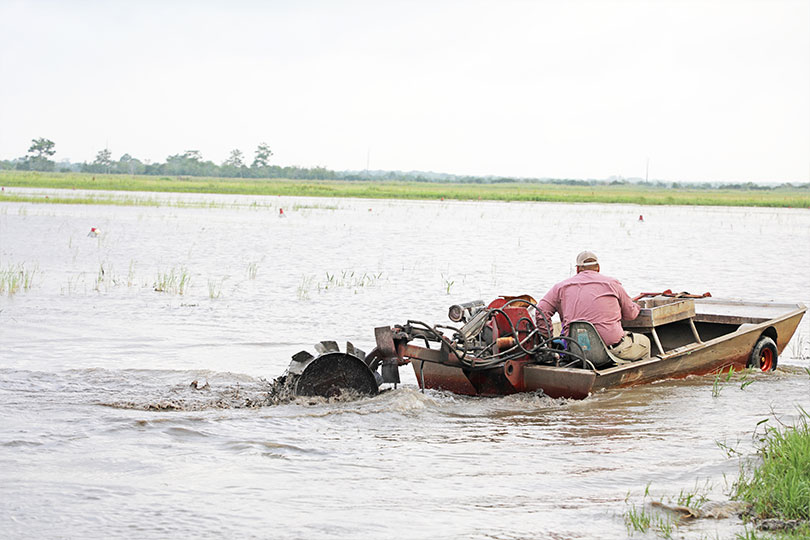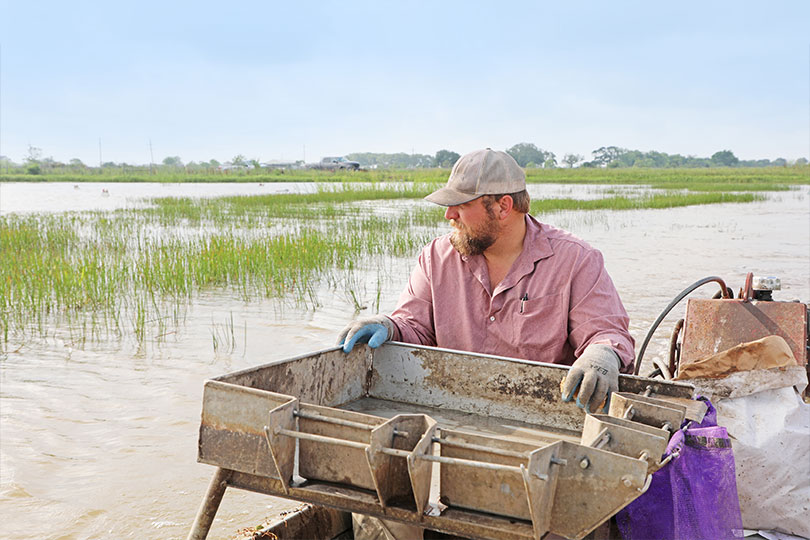By Shelby Shank
Field Editor
Before the boil and before the steam and spice, there’s the work—mud, bait and early mornings. In Hamshire, a small community along the Texas coast, Aaron Permenter reels in his crawfish harvest to share with mudbug lovers across Texas and Louisiana.
“Farming has always been in my blood,” he said. “I remember as a little kid, riding the combines and going in the field with my grandpa or working cows with my uncle.”
Those childhood memories planted deep roots, and he started farming in 2013 alongside his grandfather and uncles. But after Hurricane Harvey devastated the region in 2017, the older generation stepped back, and he stepped up.
Today, he farms 800 acres of rice and 100 acres of crawfish.

In Southeast Texas, those two crops go hand-in-hand. The same flooded fields that grow rice in the summer become crawfish ponds in the winter.
The leftover forage after the rice is harvested becomes a nutrient-rich habitat for crawfish.
“We plant rice one year, then rotate to crawfish the next,” Permenter said. “After crawfish season ends, we drain the ponds and start preparing the fields for rice again in the spring.”
Once the rice is harvested and the fields are flooded again in the fall, young crawfish begin to emerge. These aren’t wild crawfish. They’re Red Swamp crawfish that Permenter brings in from Louisiana each year to restock the ponds.
By January, the season is in full swing and runs through early June.
To catch crawfish, Permenter uses pyramid traps made of three-quarter-inch mesh wire with three inlets that allow the crawfish to enter. Each acre has 10 to 15 traps, baited with pellets that resemble cattle cubes.
“The pellets are a mixture of corn, fish oil and cornmeal,” he said. “We break the bait in half, drop it in the traps and let them soak for 12 to 24 hours. The crawfish can smell the bait, and that’s what attracts them to it.”
In cooler months, Permenter harvests every other day. As temperature rises, so does the workload. He’s out in the field six days a week, hauling in between 300 and 1,000 pounds a day.
“It varies from year to year how much crawfish we catch,” Permenter said. “Depending on the acres, we typically catch 30,000 pounds of crawfish a year and that’s a pretty good year for us.”

The process is anything but glamorous. Steering the boat with his feet, Permenter lifts traps, dumps them onto a sorting table, clears debris, fills sacks and repeats.
“You drive the boat with your feet, pick up the traps and dump them on the table. Then, you sort out the grass and excess bait,” Permenter said. “Then, you have sacks lined up around the table and you push the crawfish in there and repeat until you’ve gone through all the traps.”
Once sacked, the crawfish are loaded onto a truck and picked up by a buyer, ready to land on restaurant menus the next day.
“It’s a great feeling, especially when you can deliver a product that consumers like,” Permenter said. “We try to get the best quality product on the market that we can.”
And crawfish is a favorite for Permenter’s family, too.
“When my wife was pregnant with our youngest, we had crawfish every weekend because she wanted it,” he said. “It’s convenient when you can just go and grab some out of the cooler and boil it.”
But when crawfish season winds down in June, the work doesn’t stop. For Permenter, it marks the start of prepping for his next rice crop.
Because each season feeds into the next.


Leave A Comment